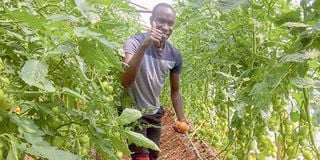Agronomist notebook: The tomato enemy during cold weather

Robert Choge harvests tomatoes in his farm in Nandi County. When farming tomatoes, it s important to note that early blight is a deadly fungal infection that affects the leaves, stems, and in severe cases, the fruits of the crop. PHOTO | NATION MEDIA GROUP
What you need to know:
- The fungal disease can easily survive in the soil and plant debris awaiting the favourable conditions for the disease to occur.
- Pruning the crop, especially the lower leaves, helps to prevent the spread since the leaves easily get infected while in contact with the soil.
- Control of susceptible weeds such as black nightshade in a tomato field is vital since it acts as an alternate host of the disease.
- Crop support in tomatoes is also vital as this increases air circulation around the plant and facilitates airflow and penetration of chemicals and bio pesticides.
I recently visited Mwikali, who grows a variety of crops that include tomatoes and capsicum, in Limuru.
As many other farmers growing the crops currently, her major challenge is early blight infestation due to the cold season, which is accompanied by rain in some places and temperature fluctuations.
Early blight is a deadly fungal infection that affects the leaves, stems, and in severe cases, the fruits.
On her farm, some of the tomato and capsicum plants in greenhouses are due for harvesting and others are a young crop at vegetative stage.
While the crops in the greenhouses are doing well, those in the open field that were at flowering stage, have leaves with brown lesions, which had concentric rings. Some of them are yellowing.
Early blight initially manifests itself on leaves as circular brown lesions on the older foliage near the ground. It thrives best in heavy dew (colder mornings), frequent rainfall and warm conditions. The disease also occurs in dry spell especially if the crop is under irrigation.
In humid areas, all the leaves may be affected but in dry areas only the lower leaves are affected spreading the disease to the other parts of the plant.
The circular brown lesions develop concentric rings and tissues around spots that are easily visible with the naked eyes.
In severe cases, the leaves turn yellow and fall off and the dry leaves may cling to the stem.
The stems turn yellow, sunken, and dry while the fruits can be infected at any stage of growth. The fruits spots are leathery, black with raised concentric rings, which eventually results in fruit-fall.
The fungal disease can easily survive in the soil and plant debris awaiting the favourable conditions for the disease to occur.
This is among the reason farmers are advised to remove weeds after tillage and put them in a heap where they can be burnt.
CROP NUTRITION
The pathogen also survives on tomato seeds thus its always crucial for the farmer to acquire certified seeds that are free and resistant to the disease.
Pruning the crop, especially the lower leaves, helps to prevent the spread since the leaves easily get infected while in contact with the soil.
While carrying out management practices such as weeding and pruning, one should use disinfected tools and work from areas that are not affected to avoid further spread of the disease.
During the rainy season, splash erosion also causes the spread of diseases as the spores are easily dispersed. In dry conditions, drip irrigation system is preferred as overhead results to the spread of the disease. The spores are also spread by wind hence the need to have windbreakers around the farm.
Control of susceptible weeds such as black nightshade in a tomato field is vital since it acts as an alternate host of the disease.
Crop nutrition should be well taken care of by applying the required fertiliser using the recommended rates in line with the soil test analysis as this maintains the crop vigour.
Crop support in tomatoes is also vital as this increases air circulation around the plant and facilitates airflow and penetration of chemicals and bio pesticides.
Also, planting the tomatoes in raised beds helps in preventing the disease since it improves the drainage and prevents the infection from spreading.
Mulching the beds using organic or plastic mulch also plays a critical role in preventing the plant from being infected since they create a barrier between the contaminated soil and the leaves.
Sometimes the flea beetles transmit the disease. Copper-based chemicals can also be used to prevent the occurrence of the disease while chemicals with an active ingredient such as mannose can also be used to control the disease.
Early blight results in lowered tomato production and increases costs. It should not be confused with late blight, which affects tomatoes, especially during the late stage of the growing season.





